Welcome to our detailed exploration of the award medals from The Great Exhibition of the Works of Industry of All Nations, held in 1851 in London, England. Often simply referred to as The Great Exhibition, this was the first World’s Fair and marked a defining moment in the cultural and industrial history of the Victorian era.
Award Medals – 1851 The Great Exhibition
All exhibitors received the Exhibitors Medal, apart from those already awarded the more exclusive Council Medal or Prize Medal. The Jurors Prize Medal was issued to at least 2,913 of the 17,000 exhibitors in the Exhibition. The Council Medal was presented to only 170 exhibitors in the Great Exhibition of 1851.
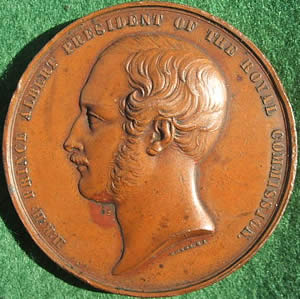
Obv: bust left portrait of Prince Albert; Diameter: 45mm. Nice bronze color.
Edge: engraved UNITED KINGDOM CLASSES 12 & 15 No.262, William Wyon designer
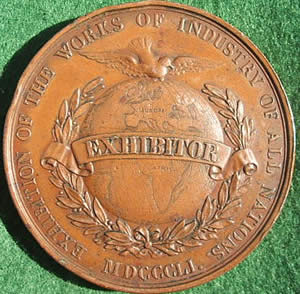
Reverse: This image depicts the reverse side of an award medal from the 1851 Great Exhibition. It is framed by a classic laurel wreath, symbolizing victory and achievement, which encircles the central inscription. The words “EXHIBITOR” are prominently featured in relief, indicating the medal’s recipient category. Above this designation, the medal proclaims its origin: “THE WORKS OF INDUSTRY OF ALL NATIONS,” which was the full title of The Great Exhibition. Below the central text, the date of the event is inscribed in Roman numerals “MDCCCLI,” corresponding to the year 1851.
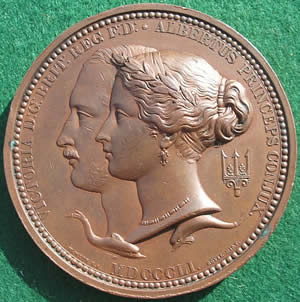
Jurors Prize Medal
The design indeed was the work of Leonard Charles Wyon, a renowned British medalist and engraver of the Victorian era, who belonged to a family celebrated for their numismatic art. This particular variety, being an official bronze prize medal, would have been of significant importance, as it was awarded to exhibitors whose entries met the high standards of innovation and craftsmanship celebrated at the Exhibition.
Around the edges of the medal, the inscription “EXHIBITION OF THE WORKS OF INDUSTRY OF ALL NATIONS MDCCCLI” is prominently displayed.
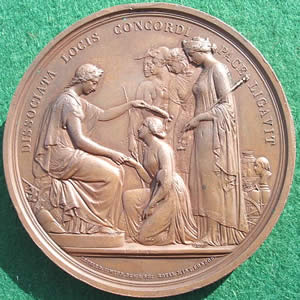
The reverse side of this prize medal from the 1851 Great Exhibition is a work of intricate artistry. It features the personification of the four continents—Europe, Asia, Africa, and America—presenting their gifts at the feet of Britannia, who sits centrally enthroned. The composition represents the coming together of different nations in peace and harmony, signifying the global unity and cooperation that the Exhibition sought to foster.
The Latin inscription “DIREXIT DEBORUM LOGIS CONCORDIA FECIT,” translates to “He directed the works by divine counsel; concord made them succeed,” emphasizing the divinely inspired wisdom and harmonious collaboration behind the event’s success. This allegorical scene, rich in symbolism and classicism, embodies the spirit of the age’s optimism and the Victorian belief in progress through industrial and cultural exchange.
More about the above medal:
The decision to present this medal to the Jurors was a gesture of appreciation for their extensive efforts in evaluating the myriad of innovations and exhibits presented at The Great Exhibition. The Prize Medal was issued to at least 2,913 of the 17,000 exhibitors in the Exhibition
Edge: engraved PRIZE MEDAL OF THE EXHIBITION GAUDET DU FRESNE CLASS XXIX. Diameter: 77mm.
This is the variety of the official exhibitor’s prize medal which
is signed in the reverse exergue LEONARD C WYON DES & SC ROYAL MINT
LONDON, and no stop after LIGAVIT. Allen says that this is the type usually
found in the presentation sets, so presumably this one “escaped”
and was awarded in error. Mr Gaudet du Fresne appears to have been a ‘feuillagiste’ – creating imaginative displays from leaves.
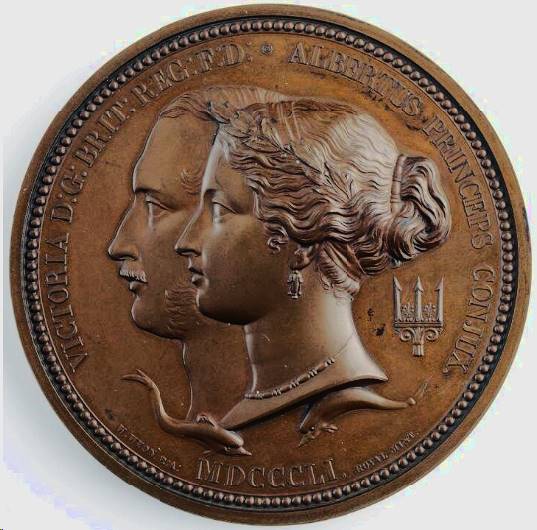
Council Medal 1851 Exhibition
The obverse of the Council Medal, a substantial 89mm bronze disc, was intended to commend exceptional ingenuity and invention. It features the majestic conjoined profiles of Queen Victoria and Prince Albert, looking toward the left. Below them are two dolphins, symbolizing Britain’s command of the seas, while a trident adjacent to the couple reaffirms the nation’s maritime dominance. Queen Victoria is portrayed with a wreath of laurel—emblematic of triumph and esteem—and is adorned with regal jewelry. A decorative beaded border encircles the edge, adding to the medal’s ceremonial gravitas.
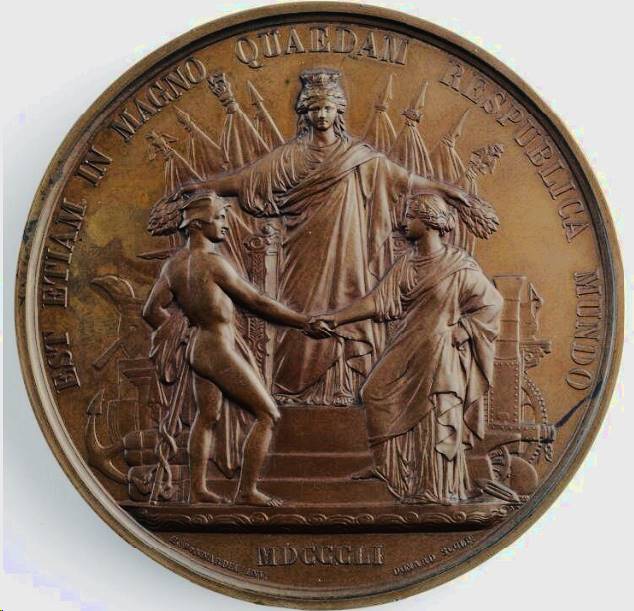
The reverse of the Council Medal from the 1851 Great Exhibition presents an allegorical tableau that serves as a testament to the British Empire’s prominence in global trade and industry. Britannia, the personified emblem of Britain, is central and majestic in classical attire, extending her arms protectively. She bestows laurel wreaths, symbols of honor and victory, upon two allegorical figures—Commerce, depicted as Mercury with his winged helm, and Industry, denoting collaborative strength—as they clasp hands in partnership beneath her.
Encircling this central scene are emblems of commercial and industrial might: textiles, a cogwheel emblematic of machinery, a shuttle representing textiles, an anvil symbolizing metalwork, and maritime symbols indicating naval prowess. The backdrop is graced by a display of international flags, implying unity and global participation in the event. This complex composition encapsulates the essence of the Exhibition, celebrating not only British achievements but also the cooperative spirit of nations united by progress and peaceful competition.
Jury For Awarding Medals
The exhibition was divided in to thirty different classes, with a separate
jury appointed for each class. Each panel of Jurors was made up of an
equal number of British and Foreign members. The Chairmen of each panel
were formed into a Council. The original idea of having three prize medals
was considered inappropriate in being able to distinguish between the
quality of awards so the Council asked for one of the medals to be withdrawn.
This was agreed by the Commissioners and this meant that there would be
a medal available for presentation to the Jurors in recognition of their
onerous task.
Of the two medals remaining for prizes, it was decided that the 77mm
medal would be awarded by the juries when a standard of excellence had
been reached for workmanship, beauty, utility and adaptability had been
attained. The 89mm Council Medal would be reserved as a reward for remarkable invention, to be awarded by the Council Chairmen, on the recommendation of the juries. The Council Medal was presented to only 170 exhibitors in the Great Exhibition of 1851.
Although the medals were issued in bronze, specimens are known to exist
in other metals. Leslie Lewis Allen notes a pattern of the prize medal,
unsigned, in a glazed frame. He also reports two Jurors medals in white
metal and Laurence Brown reports a silver example of the Prize medal.
Silver plated medals are also noted for the Prize, Exhibitor and and For
Services medal, but these were plated later after inscription.
Collectors Note: The longevity of these medals’ presence on the market is truly remarkable, considering their origin from the inaugural World’s Fair in 1851. As a passionate collector, I’m proud to possess the two variants shown above, with the second, measuring 77mm in diameter, often recognized as the primary award medal. There’s also an even larger 89mm Council Medal, which, due to its scarcity because of 170 were awarded, has eluded my collection thus far. Its rarity adds to the intrigue and desire among collectors, myself included, to one day encounter this elusive piece of numismatic history.
